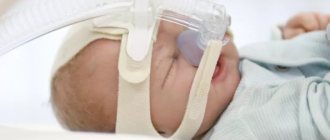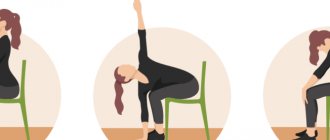According to statistics, 2% of parents experience apnea in newborns - a disorder in which the baby stops breathing for 20 seconds or more. Apnea occurs more often in premature babies. According to various estimates, from a quarter to a half of babies born at 37-42 weeks suffer from OSA (obstructive sleep apnea syndrome).
Norm
Uneven breathing in newborns during sleep is not always a problem. Parents should not worry if breathing stops:
- occur no more than once per hour;
- breathing in a sleeping child does not cause effort;
- the baby breathes evenly and deeply during sleep;
- holding your breath for less than 5 seconds;
- the baby’s heart does not slow down, the pulse does not subside, the skin does not change color.
If your baby’s breathing causes concern, you should find time and visit a pediatric somnologist – a doctor who treats sleep disorders.
Symptoms of holding your breath
Plant fiber digested in the stool of a child under one year old
A child breathes much faster than an adult. It is normal if he takes 60 breaths per minute. The sounds a baby makes when breathing are very diverse. This is due to the fact that he breathes only through his nose. The baby may sob and grunt in his sleep, which is not a cause for concern.
The infant's breathing rhythm changes during sleep. It can speed up, slow down, and sometimes stop for a few seconds. According to doctors, this is a normal condition, which they describe as periodic breathing. It is likely to occur in an infant under 6 months of age.
Unlike apnea in adults, which is manifested by snoring, a child holds his breath during sleep almost silently, and it is difficult to notice. Parents should pay attention to the following symptoms:
- irritability and tearfulness, the baby may wake up, scream and cry during sleep;
- weakness and apathy;
- lack of appetite;
- mild cough;
- after inhalation, the chest freezes;
- the baby tries to breathe through his mouth when he sleeps;
Baby trying to breathe through his mouth
- sweating;
- strange position while sleeping.
The severity of symptoms is indicated by:
- blue discoloration of lips and facial skin;
- absence of visual signs of expansion and collapse of the chest;
- a sharp slowdown in heart rate.
If a newborn can hold his breath for a few seconds, but this happens infrequently, and no other symptoms are observed, then this phenomenon is considered normal, since the baby is just learning to breathe.
Important! If you hold your breath for more than 15 seconds and there are additional alarming symptoms, you should immediately show your baby to a specialist. The doctor will determine why the baby is holding his breath and prescribe treatment if necessary.
Kinds
Infant apnea - what is it? Experts distinguish several types of this pathology.
A baby born at term may experience the following types of apnea:
- central – short-term cessation of breathing, which occurs involuntarily in infants;
- obstructive - the child stops breathing due to obstruction (blockage) of the airways.
Premature newborns may experience:
- primary apnea - observed due to difficulty in lung function immediately after the baby is born or 3-6 months after birth;
- secondary – respiratory arrest after primary ventilation.
Secondary apnea is characterized not only by cessation of breathing, but also by a decrease in pressure and a general weakening of muscle tone. This condition can provoke the further development of complications.
Symptoms
The main alarm signal is interruptions in breathing or stopping it for more than 20 seconds. You should urgently make an appointment with a doctor if your breathing pattern does not fit into the norm, and if at least one of the following symptoms is observed:
- baby's skin becomes paler or bluer;
- cyanosis appears in the mouth and nose area due to oxygen deficiency;
- snoring (indicates an obstructive type of apnea);
- The baby suffers from restless sleep not for the first night;
- enuresis (indicates disruptions in the functions of the central nervous system);
- profuse sweating occurs during sleep;
- the child convulsively gasps for air, constantly breathes through his mouth (both in sleep and while awake);
- cannot restore smooth breathing after an attack.
Due to constant lack of sleep, the baby becomes capricious, constantly cries, and gets irritated.
The main symptoms of apnea in children born prematurely include:
- episodic interruption of breathing with pauses of 20 seconds or more;
- blue/pale skin;
- slowing of the pulse (in infants it can be heard more clearly on the shoulder or fontanelle).
Doctors are well aware of when apnea in premature babies goes away, unless there are complicating factors. This occurs by 40-45 weeks of life as the nervous and respiratory systems, as well as the respiratory control center, are finally formed.
It is more difficult to understand until what age the problem will last. Seizures can occur both in infants in the first weeks of life and in children older than six months. The prognosis is given only after a complete diagnosis.
Obstructive apnea in children with adenoids: causes, danger, treatment approaches
Almost all children have adenoids, but if they are small in size (first degree), they practically do not interfere with the passage of air through the respiratory tract of a sleeping child, and OSA does not occur.
At the same time, obstructive apnea syndrome of varying severity develops in 50% of children with larger adenoids. In the second degree, at the time of the deep phase of sleep, hypertrophied tonsils cover more than half of the lumen of the airways; in the third or fourth degree, they block them completely.
During sleep, large adenoids can almost completely block the access of air to the airways
- Always remember that your snoring child with adenoids has a 50% risk of stopping breathing forever one night!
Therefore, children's snoring, especially uneven snoring, accompanied by wheezing inhalation, increased movements of the chest and its depression, periodic stops in breathing, is a reason to immediately contact a specialist for advice and a special examination.
Case from medical practice:
Moscow somnologists drew attention to a video filmed by the mother of 3-year-old Maxim M. from Kaliningrad. The woman was desperately looking for an opportunity to help her son - and she was absolutely right. As it turned out, the baby was literally between life and death. With one look at the sleeping child, specialists immediately determined a severe degree of obstructive sleep apnea, which was confirmed by polysomnography. The examination revealed 140 (!) episodes of respiratory arrests per hour. Since OSA was caused by adenoids that relapsed after traditional surgery, ENT doctors joined in the treatment: Professor Rusetsky Yu.Yu. and candidate of medical sciences Latysheva E.N. The boy underwent endoscopic removal of the adenoids, after which the problem completely disappeared.
| The chest is deformed, sinks when sighing, the mouth is open, the child snores heavily, breathes with difficulty, breathing stops on average every 2 minutes | The child does not snore, breathes evenly, constantly, calmly, through the nose, the chest is not deformed |
Sleeping Maxim before and after surgery
In general, when treating children with adenoids, ENT doctors adhere to the following rules:
- Grade 1 – no removal required.
- Grade 2 – examination is necessary to determine the presence of OSA and its severity.
- Grade 3-4 – surgery is indicated.
OSA can also develop in children with a pathological structure of the respiratory tract, for example, with a deviated nasal septum, cleft palate, hypertrophy (enlargement) of the root of the tongue, etc. In this case, as with severe adenoids, they resort to surgery.
In addition to polysomnography, SLIP endoscopy helps to decide on the choice of treatment tactics. During this study, the child is put into a light, close to natural, medicated sleep. After which, using a thin probe, his upper respiratory tract is examined to determine the presence of obstacles and determine their location.
Causes and consequences
In newborns, pathology can develop due to problems:
- with lungs or heart;
- due to disorders of the respiratory functions of the central nervous system;
- due to airway obstruction.
In premature babies, the syndrome often develops due to an immature nervous system. The reasons may also be:
- unsuccessful ventilation after primary apnea;
- birth injury;
- congenital pathologies of the heart and blood vessels;
- intrauterine infections affecting the fetal brain;
- immaturity of the laryngeal muscles;
- craniofacial pathologies;
- weak muscular corset of the upper respiratory tract.
In addition, apnea is often a complication of hereditary diseases, as well as diseases that the child has already had - meningitis, inflammation of the adenoids, asphyxia, oxygen starvation, etc.
Breathing problems are extremely dangerous for the baby's health. They can also threaten his life. When breathing stops for 20 seconds, neurons begin to die. With a longer absence of oxygen, irreversible problems begin with all vital organs - heart, lungs, bronchi.
In children older than six months, neurological problems develop with chronic apnea. The child cannot concentrate. Memory deteriorates. With hyperactivity, it is extremely difficult for a child to find contact with other children. There are problems with socialization on the playground or in the nursery.
Diagnostics
Sleep apnea is not a death sentence, and to understand how to treat it, it is enough to consult a doctor. Parents of a premature baby should make an appointment with a neonatologist. The rest go to a pediatrician, who will refer you to a specialist. The task of the otolaryngologist, neurologist, pulmonologist, cardiologist will be to identify the causes that provoked the disorders.
In newborns
Polysomnography is the main method that helps to identify pathology in children born at term. Diagnosis is carried out during sleep. Electrodes and sensors are connected to the baby’s body, which record the functioning of the respiratory system. The doctor visually monitors breathing pauses, their number, frequency and duration.
Additional examinations are carried out to identify the causes. For example, if you suspect:
- For obstructive apnea, anterior rhinoscopy is prescribed, which makes it possible to detect the causes of complicated nasal breathing;
- for disturbances in the functioning of the heart - ECG, ultrasound of the heart and brain;
- for pneumonia - radiography.
The doctor may also prescribe an MRI, CT scan, brain encephalogram and other examinations.
In premature babies
Most often, premature babies suffer from central apnea. Therefore, neurosonography becomes the main diagnostic method. Otherwise - ultrasound examination of the brain. The brain stem, where the respiratory center is located, is especially carefully studied. The doctor analyzes the nature and dynamics of brain processes and makes a conclusion about the presence or absence of pathologies.
If abnormalities are detected, a lumbar puncture is prescribed. With its help, they look for hemorrhages or inflammation in the brain.
Reasons for holding your breath
Apnea occurs in 1 in 100 newborns. Infants born at term have the lowest incidence of apnea (about 0.1%), decreasing in accordance with the degree of fetal maturation. Breath holding occurs in 5-7% of children born after 34-35 weeks of pregnancy, and in almost all newborns after 28 weeks of pregnancy.
The most common cause of breath-holding in a child's sleep is the incomplete development of the mechanisms that regulate the respiratory rhythm, associated with the immaturity of the premature baby.
Other causes of apnea in infants:
- infections;
- perinatal hypoxia;
- congenital metabolic pathologies;
- unsuitable ambient temperature;
- maternal use of opioid medications or medications containing high doses of magnesium in the period preceding childbirth;
- the use of medications to treat infants that reduce the function of the respiratory center in the brain;
- intracranial bleeding;
- necrotizing enterocolitis;
- heart diseases;
- low blood glucose.
Premature baby
related to the obstructive nature of the disease come to the fore
- anatomical abnormalities - Robin's syndrome, cleft lip, etc.;
- allergic reactions;
- heavy weight;
- enlarged tonsils and growth of adenoids;
- spasms of the laryngeal muscles;
- delayed formation of cartilage tissue, resulting in excessive softness of the palate.
Robin's syndrome in infants
What to do for apnea: first aid
During an attack, parents should provide first aid to the baby by following simple steps:
- Take the baby in your arms, stroke or pat him on the back, rub his arms, legs, earlobes, tickle his heels or pat them.
- Spray your baby with cool water.
- To make breathing easier, place your baby on his tummy with his head turned to the side.
If the baby's breathing has not returned, perform artificial respiration:
- Place your baby on a hard surface on his back.
- Place a cushion from a sheet or towel under the shoulder blades so that the head tilts back slightly.
- Hold your head and inhale air into your mouth and nose at the same time. The air portions should be very small.
- If the child does not wake up after 6-8 breaths, perform chest compressions.
Treatment
During hospitalization, doctors perform the necessary manipulations to stabilize the baby’s condition. Premature babies are placed in an incubator. If the attacks recur there, the child is connected to a ventilator.
Medication prescriptions and clinical recommendations are made taking into account the causes of the disease. For example, to treat infant apnea caused by excessively enlarged adenoids, an ENT specialist prescribes surgery to remove them.
Diagnosis and treatment methods for snoring
In order to establish the true cause of an unpleasant symptom and select the appropriate treatment regimen, an ENT doctor can use the following research methods:
- X-ray diagnostics of the sinuses or computed tomography (CT);
- endoscopy – an optical examination that allows a detailed examination of the nasal cavity;
- a smear for microflora, which is taken from the mucous membrane of the nasal cavity or pharynx;
- A detailed blood test will reveal the presence of an inflammatory process in the body.
If necessary, the doctor can refer the small patient to specialized specialists: an allergist, surgeon, pulmonologist or endocrinologist, if the cause of the pathology is outside his specialization.
If, as a result of diagnostic measures, deviations in the development of ENT organs have been identified, the specialist will use one of two treatment methods:
- Conservative. Drug therapy is effective if an infectious or allergic nature of snoring is detected.
- Surgical intervention is indicated in the presence of congenital anomalies or neoplasms in the nasal cavity.
Prevention
Simple recommendations will help prevent the development of apnea in infancy:
- it is necessary to regularly ventilate the room where the child sleeps;
- the air in the children's bedroom should not be excessively dry;
- Before going to bed, the child should not be overheated;
- bedding must be selected correctly: a hard thin mattress, a low pillow, pillow filling and blankets made from natural materials (filling made from natural bird feathers is not acceptable);
- It is prohibited to use aerosols (both household products and perfumes) near the baby;
- tobacco smoke is strictly prohibited.
To control a child's sleep in the first months of life, it is worth placing his crib in the parents' bedroom.








